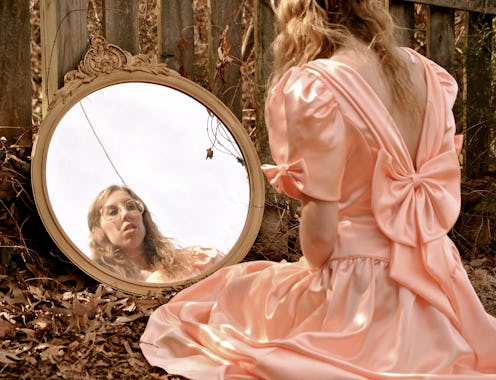Fashion
Should We Stop Comparing Catwalks To Real Life?

Fashion designers are often asked why they don't opt for more realistic looking models to wear their creations on runways. Inspired by the catwalk of Elie Saab, featuring dreamy gowns and an enchanted forest, my question is: Is fashion supposed to be a fairytale? Is it our way of escaping from reality? Catwalk models seem unreal — unreachable. They create an image that is not achievable for the average person. But should we berate them for this or it that exactly why they exist? And does our current stride towards body acceptance and self love have a place for these traditional catwalks and their models?
Saab himself uses the hashtag #chasingadream to describe his Spring/Summer 2015 collection and I have to admit that I was transported to a daydream when watching the catwalk video on his site. Those dresses are stunning — they are works of art. And maybe that is how we should enjoy them. Ignoring, for a moment, the fact that I would never, ever be able to pay for one of these gowns, I couldn't help daydreaming myself walking into a Hollywood party wearing one and turning heads. Then that voice in my head said, "You'd look like a cupcake if you wore that with your short, stumpy legs; you'll never have a figure like that." Perhaps, though, we need to categorize things in our head in such a way to have a clear idea of what is art and what is clothing design. Clothing design that is intended to be worn by real live people should have catwalk shows that reflects the average person on the street. On the other hand, there should be a place for these towering works of art.
To be honest, I'm playing devil's advocate a little. Of course I recognize how damaging it is to enforce a regime of fashion shows featuring dangerously underweight models. Studies have shown that the images we are exposed to on a daily basis influence our perception of the world and it is undeniable that there is an enormous pressure put upon young women to look a certain way. For many, it could be argued that catwalk shows contribute to this.
Subsequently, there are movements towards a more normalized catwalk experience; the work of Carrie Hammer is fantastic, for example. She puts women on her catwalk who are role models — inspirational ladies regardless of their size or shape. Last year we saw Prada mixing mens and womenswear on the catwalk because it's "more real." And Israel also made a bold and positive step forward by banning underweight models from their catwalks and advertisements.
So let's look at our relationship with our childhood fairytales: They give us a fantasy word to dream of and utilize to escape from reality. We read fairytales to our kids to give them a relaxed, calming feeling before going to bed. No one ever complains if they are not realistic — no one runs around wearing glass slippers and kissing frogs. Is, then, the catwalk the grown-up version of our children's fairytale stories? And if it is, do we need to stop expecting for reality to get a look-in when it comes to catwalk shows?
It seems clear that there is something in our minds that makes us accept certain art forms as works of fiction whilst simultaneously expecting others to represent reality. We can happily watch a film featuring a lady with three boobs without feeling pressured to go out and get an extra breast implant. Paintings, sculptures and movies are free from the shackles of reality, so maybe catwalks should also be given this leeway. This is why I love Saab's enchanted forest catwalk and #chasingadream hashtag: He makes it very clear that he is creating a "dream world," his own personal fairytale. Not to mention the fact that the dresses are OMG-Amazing and on a very practical note, they have pockets! I have vowed to never again buy a dress without pockets so it makes me happy that Elie Saab Haute Couture can stay on my To Buy list. I want them all!
I have a feeling that I'm going around in circles with this topic and that's because I'm not sure what to conclude, to be honest. We are undoubtedly influenced by the images we see every day, and our view of the world and of ourselves is — in part — formed by the representations of the human figure in the media.
Catwalk shows provide one very restricted image of how people should be shaped, so if I put on my body-acceptance-hat, I feel like something needs to change in that area. Of course, these dresses would look ridiculous on someone with my short legs; but that is because in this moment, fashions designers create their art with one very specific shape in mind. But if they would take a step towards the reality that people come in all shapes and sizes and start designing for models of all shapes and sizes, would their dresses be less beautiful?
When I put on my art-lover-hat and consider these dresses as pieces of magic from a fantasy world, I fall head over heels in love with them and the size of the canvas is no longer relevant because it is about the fairytale art. So, I don't know. Maybe reality is — ultimately — not always relevant on the catwalk.
Images: Elie Saab; Flickr/tori wright; Carolco Pictures; Twitter